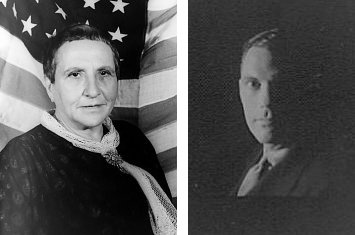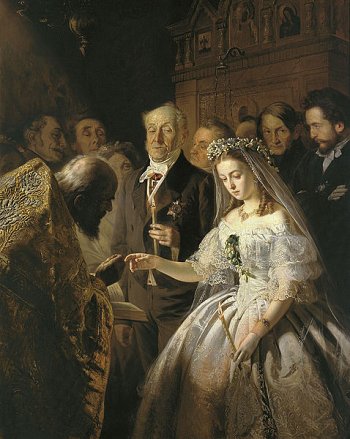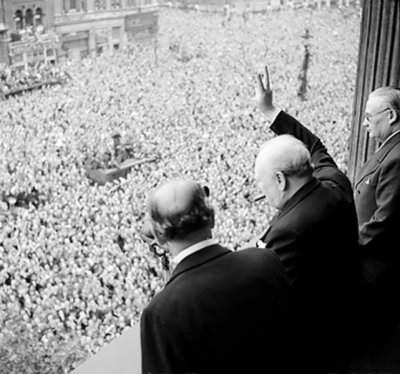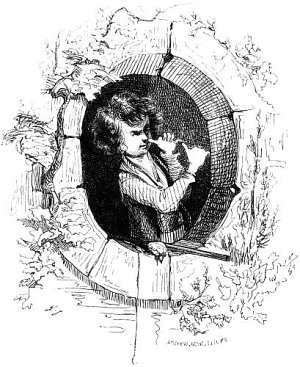Author Relations

When Bennett Cerf published Gertrude Stein’s Geographical History of America or the Relation of Human Nature to the Human Mind in 1936, he included this “Publisher’s Note”:
This space is usually reserved for a brief description of a book’s contents. In this case, however, I must admit frankly that I do not know what Miss Stein is talking about. I do not even understand the title.
I admire Miss Stein tremendously, and I like to publish her books, although most of the time I do not know what she is driving at. That, Miss Stein tells me, is because I am dumb.
I note that one of my partners and I are characters in this latest work of Miss Stein’s. Both of us wish we knew what she was saying about us. Both of us hope too that her faithful followers will make more of this book than we were able to!
Interviewing Stein on his radio program, Cerf said, “I’m very proud to be your publisher, Miss Stein, but as I’ve always told you, I don’t understand very much of what you’re saying.”
She said, “Well, I’ve always told you, Bennett, you’re a very nice boy, but you’re rather stupid.”
In a Word

opsigamy
n. marriage at an advanced age
benedick
n. a newly married man
shunamitism
n. rejuvenation of an old man by a young woman
High Places

An admirer once asked Winston Churchill, “Doesn’t it thrill you to know that every time you make a speech the hall is packed to overflowing?”
Churchill replied, “It is quite flattering, but whenever I feel this way I always remember that if instead of making a political speech I was being hanged, the crowd would be twice as big.”
Signs and Wonders

Morris Garstenfeld repeatedly greeted a Brooklyn neighbor “by placing the end of his thumb against the tip of his nose, at the same time extending and wiggling the fingers of his hand.” Is this disorderly conduct? That question fell to Kings County Judge J. Roy in 1915.
“What meaning is intended to be conveyed by the above-described pantomime?” Roy mused. “Is it a friendly or an unfriendly action; a compliment or an insult? Is it a direct invitation to fight, or is it likely to provoke a fight?”
He declared that the gesture is well known among boys, and that it should be abandoned by men. In Garstenfeld’s case, the “nasal and digit drama” tended “to show a design to engender strife,” and the fact that Garstenfeld had done it repeatedly showed that he meant to annoy his victim “to the limit of patient endurance.” He affirmed Garstenfeld’s conviction.
What Are We?
A riddle by Jonathan Swift:
We are little airy creatures,
All of different voice and features:
One of us in glass is set,
One of us you’ll find in jet,
T’other you may see in tin,
And the fourth a box within;
If the fifth you should pursue,
It can never fly from you.
What are we?
Last Effects
In October 1864, Indiana farmer John VanNuys received a letter informing him that his son had been killed in the Battle of Chaffin’s Farm in Virginia. He had been shot in the throat while retreating from a line of Confederate rifle pits. “Within twenty minutes our forces rallied and took the ground,” wrote the quartermaster, “but while the rebels held the ground, they had stripped your son of everything except shirt and drawers.”
A few days later VanNuys received an envelope postmarked “Old Point Comfort, Oct. 10.” Inside was a note in his son’s handwriting:
This testament belongs to Captain S.W. VanNuys, Acting Ass’t. Adj’t. General 3d Brigade, 3d Div., 18th Army Corps. Should I die upon the field of battle, for the sake of a loving mother and sister, inform my father, John H. VanNuys, Franklin, Indiana, of the fact.
Below this someone had written:
Mr. John H. Vanings: It is my faithful duty to inform you that your son was killed on the 29th of the last month near Chaffins farm, Va. I have his testament. I will send it if you wish it. From your enemy, one of the worst rebels you ever seen.
The sender had signed it only “L.B.F.” His identity is unknown.
The World’s Littlest Skyscraper

During the oil boom of 1919, Wichita Falls, Texas, was desperate for office space, so investors jumped at developer J.D. McMahon’s offer to build a 480″ high rise downtown.
When the building turned out to be four stories tall, they double-checked the blueprints. McMahon had promised a building 480 inches tall, not 480 feet. And that’s what he’d delivered.
By that time he had decamped with the money.
Some Enchanted Evening

In 1921 Charles Purdy worried that modern foods require too little chewing, resulting in “decayed teeth, undeveloped jaws, and various other complications due solely to the lack of exercise attendant on proper mastication.”
The answer, he decided, was a bite plate that can be attached to the wall by a spring. “By movements of the head, the device will receive a series of short jerks or impulses which will be transmitted to the teeth in order to produce a strain thereon, which strain serves to give the several organs of the mouth and head a proper exercise to maintain the necessary circulation therein.”
When used in tandem, as shown, this has all the makings of a romantic candlelight interlude as the exercisers “pull in opposite directions similar to the so-called ‘tug-of-war.'” What did this sound like?
A Man’s World
When Long Island filmmaker Ellen Cooperman divorced her husband in 1975, she changed her last name to Cooperperson because it “more properly reflects [my] sense of human equality than does the name Cooperman.”
State Supreme Court Justice John Scileppi refused to ratify the change, saying that it “would have serious and undesirable repercussions, perhaps throughout the entire country.” He cited “virtually endless and increasingly inane” possibilities: A person named “Jackson” might seek to become “Jackchild,” a “Manning” might prefer “Peopling,” or a woman named “Carmen” might want to be “Carperson.” “This would truly be in the realm of nonsense,” he said.
Undaunted, she appealed Scileppi’s decision and won in 1978. She’s still using Cooperperson today.

